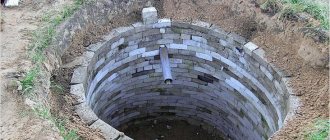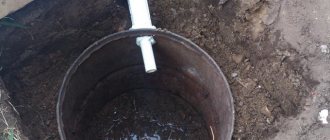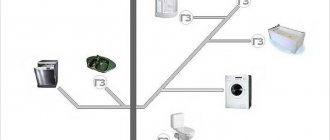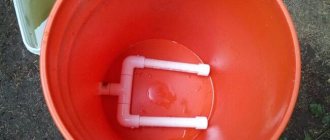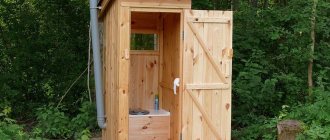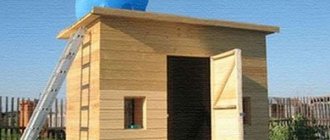Convenient and high-quality sewerage in a bathhouse is the result of precise design planning and an intuitive understanding of how to properly position the drainage in a bathhouse, and what should not be done under any circumstances. A good help in making sauna sewers are the most successful designs published by bathhouse enthusiasts.
The distance from the bathhouse to the drainage pit can be quite large
Methods for organizing wastewater disposal
When starting the construction of a bathhouse on your own site, and considering suitable projects, you must immediately work out how to properly install a sewer system in a bathhouse. This is primarily due to the fact that the laying of a wastewater drainage system, no matter how it is organized, is carried out at the stage of foundation work for the bathhouse.
Sewerage in a bathhouse can be organized in two ways:
- Pressure type with the installation of special-purpose pumping equipment that ensures the selection of sewage waste. This method is good to use when arranging bathhouses below ground level, for example, in a basement.
- Gravity drainage, in which wastewater is discharged due to the slope of the laid pipelines, is the most generally applicable.
Scheme of the design of a free-flow drain in a bathhouse
When designing a bathhouse sewerage communication, it is necessary to take into account the arrangement of the following components:
- drainage well or place for collecting and processing wastewater;
- pipeline both external and internal;
- drainage devices in garbage rooms (ladders, gutters);
- odor removal system (ventilation duct, siphons).
Manhole - what is it?
The essence of this structure is extremely dubious if you make 2 sewer pipes, as described in the section above, but the miser pays twice, as is known. It’s still better to make a viewing well, especially since its cost is only a few hundred rubles, but the benefits can be significant.
It consists of 1 concrete ring, which is located ½ of the way to the first tank. As a rule, this is the junction of two VVC pipes (or durable plastic). The ring is buried in the ground, on top is a slab and a hatch, and even higher is insulation or earth. The pipe should pass through a concrete ring 25 centimeters from the floor, the joint should be in the middle.
If any problems arise, for example, if the channel is clogged, you can unsolder them, clean them, and solder them again in literally 1 hour of work. This is much easier than trying to do something with one pipe 4-6 meters long. Actually, the relevance of the inspection ring very rarely arises, because with a well-made sewerage system, it is perfectly cleaned by itself, no additional actions are required.
Criteria for choosing a sewer system
When designing a sewerage system in a bathhouse, it is necessary to take into account several main points on which the choice of its most optimal device depends.
Options for the water outlet device in the bath
- Characteristics of the soil in the area intended for water drainage, its absorption capacity and susceptibility to swelling.
- Depth of groundwater, location of the natural water intake zone.
- Structural organization of the bathhouse, intensity of its use, expected volume of wastewater and its composition.
- The presence of a central sewerage system or a dedicated equipped septic tank.
- The height of the level difference between the location of the bathhouse and the exact planned drainage well.
- Budget for drainage infrastructure.
Sewer Design Guide
The basis for this event is the design of a building - a bathhouse, indicating the location of plumbing fixtures. A competent designer will arrange them all sequentially along one axis in advance to simplify installation and minimize financial costs. The sequence of actions may be as follows:
- Create a graphic display of the sewer system for a bathhouse, indicating the dimensions of each element of the internal wiring design.
- Provide a connection on each plumbing fixture via a siphon to create water seals; this article covers this point in more detail.
- Before connecting to the riser, an inspection is installed.
As the system moves away from the starting points, the pipe sizes can only be changed upward:
- a drain from the sink can be made from a 40 mm pipe;
- It is better to install a drain pipe with a diameter of 50 mm from the shower room through the drain;
- The external sewerage drainage line is selected at a size of 100 millimeters. Just like the connecting sections between individual sections of a multi-stage septic tank.
- At the point where the outlet pipes are connected to the riser, it is necessary to install an air valve to prevent the water seal in the siphons from breaking. Installing a drain pipe is in most cases unacceptable.
- External sewerage pipes for a bathhouse require insulation using a heating cable. In this case, warm air will flow inside the system, protecting it from freezing, which can cause rupture of the earthenware plumbing. Therefore, it is undesirable for a bathhouse to install a fan pipe through which it will exit into the outside space.
Otherwise, the design of the sauna sewer system does not differ from typical devices for similar purposes.
Construction of a wastewater storage tank
Collection and processing of wastewater is one of the main activities of the entire complex of works on the installation of bath sewerage in the absence of centralized sewerage systems nearby. In this case, it is necessary to arrange a container on your own in which the wastewater will be collected. This can be done in several ways, depending on the technical features of construction and the availability of financial capabilities.
The process of installing a septic tank for a bathhouse
Schematic diagrams for constructing wells can be as follows:
- An industrial septic tank with a built-in waste treatment system. This is the most expensive solution, which is advisable to install on the entire complex of wastewater on the site. To arrange it, as a rule, specialists in the organization of drainage systems are invited.
- A storage well with a forced pumping system when filling.
- Drainage well for sewage purposes with natural absorption of liquid into the soil. The arrangement of such a system can easily be done independently, including from scrap materials. However, in areas with close groundwater, such a system will be ineffective.
An example of a drainage well for a bathhouse - Organization of drainage wells for sewerage with an overflow system of 2-3 tanks. It is considered the most environmentally friendly system for organizing wastewater on a site, accessible for independent implementation. The principle of operation is the sequential purification of waste using special bacterial cleaning agents to the stage of almost pure water, which is directly absorbed into the soil. It should also be noted that such a system would be the best option if the sewage system involves draining waste from the toilet.
Depending on the choice of circuit diagram, it is necessary to select the material for manufacturing. The following options are possible:
- plastic containers, for example, Eurocubes or other containers of the appropriate volume and composition;
- factory-produced concrete rings;
- pouring a concrete box directly on site;
- brickwork laid in a checkerboard pattern with drainage gaps.
An example of finishing a drainage well with bricks
Once the material and design of the device have been selected, it is necessary to select the optimal location for construction and ensure proper preparation of the pit for burial or construction of the container.
Design and design of a drainage well
In this case, the following rules must be observed.
- The distance from the well to the bathhouse itself must be at least 3 meters.
- If a well with natural drainage is installed, the distance to the drinking well must be at least 30 m.
- A drainage well, which involves natural filtration, should be located no closer than 2 meters to the border of the site.
- When calculating the size of the pit, it is necessary to take into account the required volume of the container, which directly depends on the planned volume of water consumption, and the calculation must be made from the point of insertion of the pipeline.
- The depth of the well must be such that the pipeline entry is at the level of soil freezing in order to avoid freezing of the system and stagnation in the pipes.
After completing the excavation work to prepare the pit, its bottom and edges must be coated with a clay composition to avoid shedding of the edges, as well as adding a sand cushion and drainage layer if necessary.
Drawing and names of drainage well elements
In this case, it is necessary to take into account:
- the layer of sand cushion should be larger when constructing a well on clay and loamy soils, since they are more susceptible to swelling;
- the drainage layer must be at least 50 cm if a drainage type branch is made;
- As a rule, coarse gravel is used to construct a drainage layer.
When arranging waste tanks, it is also necessary to provide for the presence of ventilation outlets in the bathhouse, which will facilitate efficient waste processing and eliminate unpleasant odors.
System type
There are three types of sewers, which differ in design, installation, and technical characteristics.
Nadornaya
A drainage system in which wastewater and waste are discharged under pressure. The pressure is created by a pumping station or household pump. Such systems are installed if non-pressure structures cannot cope with pumping out liquid. Features of pressure sewers:
- dependence on connection to the electrical network;
- high price compared to non-pressure systems;
- the need to insulate the pipeline for the winter.
The pump can be installed outdoors or indoors.
Gravity
The second name for such a system is gravity. Waste water and waste flow down the pipe under its own power thanks to the corners of the pipeline. Advantages:
- low price;
- reliability, durability;
- ease of installation work;
- work without connection to the power supply network.
Flaws:
- It is important to accurately observe the slope when assembling the pipeline.
- A non-pressure system cannot be built underground if the terrain is complex and uneven.
Mortise
This is a method of connecting a drain pipe to a sewer. This option is available for baths located within the city and large settlements. Before you crash, you need to contact your local authorities. To connect the bathhouse to the pipeline, you must conclude an agreement and pay for the service.
Features of laying sewer pipes
The most relevant material for organizing wastewater disposal today are plastic pipes, which, due to their properties, have replaced pipes made of cast iron, metal and asbestos concrete. They have a long service life, are wear-resistant, easy to work with during installation, and also have a low cost.
To connect the pipes, appropriate connecting modules or fittings are provided, which have a variety of configurations to perform complex connections and routing of pipelines.
An example of laying sewer pipes in a bathhouse
Laying of external sewerage pipes is carried out in prepared trenches, prepared taking into account the following features:
- the recommended diameter of the sewer pipe in a private house is 100 mm;
- the slope of the pipes in the trench for gravity or free-flow sewerage must be at least 2 cm per linear meter;
- the depth of the trench must be made taking into account data on soil freezing in a particular area;
- it is allowed to use less depth of the pipeline using insulation with appropriate materials;
- the bottom of the trench must be filled with sand to create a sand cushion and level the slope;
- in case of large differences in the height of the site or the need to turn the main line, it is necessary to install additional inspection wells to service the system.
Example of installation of inspection wells
The joining of the pipeline to the sewer well is carried out using the tie-in method with sealing the joint. The pipeline is supplied to the bathhouse itself through a strip foundation by installing the pipe into the technological holes and sealing the connection point with cement mortar. The video shows the process of laying sewer pipes.
Types of bath sewers
In order to avoid problems with regulatory authorities in the future, do-it-yourself sewerage in the bathhouse must be installed in accordance with the requirements of SNiP 2.04.03-85 “Sewerage. External networks and structures.” This document outlines all the basic rules, regulations, requirements and specific recommendations that will help you correctly approach the organization of this important system. Bath sewerage is necessary to drain water from the steam room, washing room, and bathroom (if any). If it is absent or installed incorrectly, moisture will accumulate on the floor and in the underground, leading to rotting of the wood and gradual destruction of the foundation, the appearance of mold, mildew and an unpleasant odor.
Depending on the design of the bathhouse and the topography of the site, the system can be of the following types.
- Free-flow sewerage. It is a gravity-flow system, where drainage is provided through an inclined pipeline. It can be organized only in areas where the terrain allows for a pipe slope of at least 2 percent (2 cm for every meter of line). Gravity drainage is the most common option for bath sewerage. Its main advantage is its efficiency, ease of arrangement and operation. At the same time, due to the lack of pressure, the system easily becomes clogged (even with accumulation of hair), and the outflow is quite slow.
- Pressure sewer. Provides for the forced removal of water and sewage using a pump. The main disadvantage: the need for special equipment and energy consumption, dependence on electricity. However, in some cases it is very difficult to do without this option. Most often, the problem occurs when groundwater rises close to the surface, which makes it impossible to bury the sewer pipe to create a slope. This circumstance forces the pipeline to be installed horizontally, which counteracts the movement of water by gravity. The advantages of a pressure system include faster drainage (over a considerable distance) and a lower likelihood of pipe clogging.
- Connection to centralized sewerage. The presence of such a possibility eliminates many problems with organizing the accumulation, purification and disposal of waste liquid. However, often the connection is no cheaper than your own sewer system, especially when the main highway is remote. In addition, to connect, you must obtain permission and involve the relevant organizations.
Any of the options considered implies the presence of 2 components: an internal and external sewer system.
The internal sewage system is located within the bathhouse and is needed to collect liquid from all rooms, and the external part ensures its drainage and transit, accumulation and purification.
Installation of internal sewerage outlets
The laying of pipes for equipping internal premises with sewerage depends on the planned method of arranging the floor, the functional purpose of the premises and the number of drain points.
In small-volume baths, water is drained directly from the washing room . Other options involve draining wastewater from several points, including a toilet and additional water supply points, for example, a shower or washbasin.
An example of a sewer outlet in a bathhouse
All this must be taken into account when planning a bathhouse in order to ensure the necessary technological conclusions when pouring the foundation. The material for covering the floor is also of no small importance for how the drainage in the bathhouse will be organized.
- Organization of sewage system with wooden floor. In this case, the calculation and laying of the floor covering is carried out in the traditional way, that is, logs are laid on the support pillars, onto which the floor boards are fixed.
The process of laying floors in a bathhouse
When fixing the boards in the washing room, a technological gap is made between them to drain the water, which is 50 mm. Continuous laying of boards is also allowed; in this case, it is necessary to ensure that the floor slopes to one side for drainage. However, it should be noted that with a sparse method of flooring, the boards will be better ventilated and dry, which will ensure their longer service life.
A concrete base is installed directly under the floor, into which a sewer outlet is built. To ensure floor ventilation, the distance from the concrete to the boards must be at least 15 cm. - Installation of sewerage system with tile floor. In this case, specialized drains are used to drain water, which are a water intake lattice module with a pre-installed hydraulic lock. The drain must be placed directly flush with the floor, and the tiles must be laid, observing the technological slope. As a rule, the ladder is installed in the center of the room, and the slopes are made in the form of an envelope.
Diagram of a drain in a bathhouse
If there is a need to provide drainage from two rooms separated by a wall, then to simplify the sewerage system, gutters are used, which are run along the wall and passed under the wall common to the two rooms. In this case, the gutter is arranged, like the ladder, at the same level with the floor, and the slope of the floor is made evenly towards the gutter.
Examples of design and arrangement of drains in a bathhouse Work on laying internal pipelines is carried out in the following sequence.
- After completing the installation of the main foundation frame for the bathhouse itself, it is necessary to fill a sand cushion of at least 15 cm and compact it to ensure a technological slope;
- After this, a pipeline system is laid with outlets of vertical risers to the points of sewer outlets, equipped with connecting fitting modules;
- To prevent construction debris from getting into the pipelines, temporary plugs must be installed at the ends of the pipes;
- A ventilation pipe is also installed in the common pipeline, which is subsequently fixed to the wall.
After completing all the steps for laying out the pipes, pour the concrete solution, taking into account the following points:
- the height of the concrete above the pipes must be at least 10 cm;
- it is necessary to ensure the slope of the concrete base in accordance with the planned type of floor covering.
The final stage of installing a sewer system inside the bathhouse is laying the floor covering.
The process of laying the floor in the bathhouse
Preparation and design
When the location of the trench has been decided, you need to outline its boundaries. To do this, you need to use wooden pegs and thick white thread. Place the pegs around the perimeter of the future trench and tie them together with thread.
To prepare the site, you need to perform several steps:
- Clear the area in the area of the waste pit.
- Test the ground with a metal rod for the presence of other communications. If you have a metal detector, you can use it.
- Dig a well to drain waste from the bathhouse.
On sale you can find ready-made rings for sewer wells. The optimal depth for a small bath is 2 meters.
Materials and tools
Consumables, tools:
- large diameter plastic pipes;
- couplings;
- shovels - bayonet, shovel;
- sealant for joints.
If the installation of a sewer pipeline is carried out in a built bathhouse, you will need tools to create holes in the floor and foundation of the building in order to remove the pipes.
Installation of the system during the construction phase
Pipeline laying during the construction of a bathhouse:
- The depth of the pit for laying pipes depends on the region in which the bathhouse is being built. For the south - 70 cm, for the north - 150 cm, for the middle zone - up to 120 cm.
- First, a large diameter pipe is laid. When placing it, you need to remember about the slope towards the cesspool.
- Small diameter pipes are laid from the main pipe to the top of the building. Drains are routed to the toilet, shower, washbasin, steam room, and washing room.
- To understand how correctly the tubes are tilted, you need to pour 1–2 liters of water into them. If the same amount of water flows out of the pipe, then the system has no leaks and is working correctly.
- When the pipeline is assembled, it needs to be insulated. For this you can use fibrous materials and foam boards.
After insulation, you can fill the trench with earth.
Laying in a finished building
Installation:
- The first thing you need to do when laying a sewer system in a finished room is to open up the floor where the future drain will pass.
- For the main pipe, you need to make a hole in the side of the foundation. Connect it under the bath with pipes from the drain points.
- Restore the flooring. Apply sealant to the places where the pipes pass through the floor so that water does not flow through them under the bathhouse.
All that remains is to bring the pipeline to the septic tank or cesspool.
Removing sewer odor
To eliminate the unpleasant odor from the sewerage system in bathhouses, it is necessary to install a water seal.
- The simplest option is to install a siphon in the pipes, which provides an artificial water plug and prevents the penetration of odor. The disadvantage of this method is that when the water evaporates from the siphon, the unpleasant odor may resume.
- Another option is to install a so-called dry water seal, which is a design with a valve that opens under pressure and, in its absence, closes the pipe.
Diagram of a drainage device in a bathhouse
An additional means of eliminating stagnation in the water supply, which then begins to smell, is the installation of an exhaust ventilation pipe; its outlet should be made indoors at a height above the ridge of the bathhouse.
Installation of a sewer pit
In areas with soils that slowly drain water, it is recommended to install systems with a sewer pit. It is made of waterproof materials, so it effectively drains liquid waste through the sewer pipe outside the site.
A persistent unpleasant odor is the main problem that can be encountered when using a sewer pit. The best way to combat odors is to install a hydraulic seal made of concrete or metal, which requires compliance with certain rules:
- The entrance hole to the sewer pipe pit is arranged at a height of up to 12 cm from the bottom level.
- A plate is mounted under the waste pipe without additional fixation from below.
- A technological gap of 6 cm is maintained from the bottom of the pit to the installed plate. This is enough to make the correct water seal.
The shutter is filled with liquid to prevent unpleasant odors from entering the room from the pipes.
When choosing a suitable drainage design, it is recommended to consider the following parameters:
- soil type on the land plot;
- level of soil freezing in the cold season;
- dimensions of the bath, intensity of its use;
- the presence of an existing drainage system on the site;
- Possibility of connection to the central sewerage system.
On sandstones, it is better to equip a drainage system with a drainage well. For clay and loamy soils, a device with a pit and a septic tank is suitable.
Do-it-yourself sewerage installation
In many cases, especially with a limited budget, a do-it-yourself sewer system for a bathhouse will be a fairly simple and economical solution during construction.
Drawing of a simple sewage system in a bathhouse
As a rule, arranging water drainage for a small bathhouse in a private house requires knowledge of the principles of water drainage, desire, time for construction and a certain amount of the most necessary material.
Nature of waste
Drains from the bathhouse are classified as “gray”. As a rule, this is water containing soap suds, fatty acid derivatives, and surfactants. In addition, the wastewater contains hair, skin and horny inclusions in small quantities.
However, if you plan to build a bathhouse with a toilet, then the drains will be classified as “black”. The treatment of such wastewater must be taken more seriously, as it poses a serious threat to the ecology of the site. To clean up “black drains” it is necessary to build a regular septic tank with sealed settling chambers.

